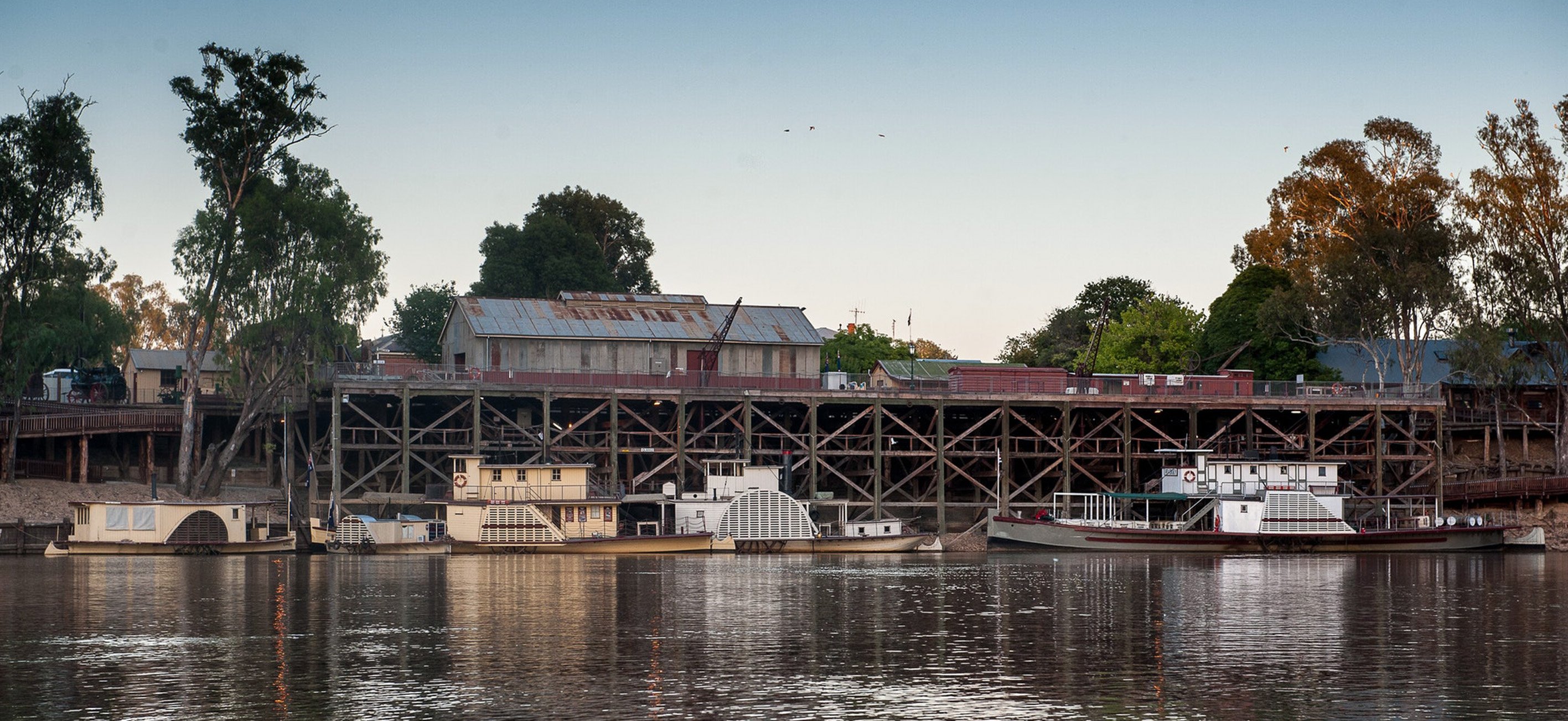
Echuca, pronounced "Etch-oo-ka" is an Aboriginal name that translates as "meeting of the waters". Three great rivers meet here: the Goulburn, the Campaspe and the mighty Murray.
You'll want to start your exploration at the historic port of Echuca, where the Discovery Centre whisks you through the plucky town's remarkable trading history with eye-catching displays, well weighted to inform and illuminate without overloading you.
You'll learn about Henry Hopwood, an ex-convict, who founded Echuca. In 1850 he bought a small punt, which operated across the Murray River near the Campaspe junction. The relatively small settlement, then known as "Hopwood's Ferry", became Echuca as the town grew.

Echuca quickly became one of Australia's busiest inland ports and paddle steamers and barges ferried supplies throughout the vast interior via the river network. The original red-gum wharf was constructed in stages from 1865 as a three-level structure to allow for the rise and fall of the river, ultimately reaching a length of 1200m. Water levels could change by as much as 12m, in flood.
Only a small section of the wharf remains today, magnificently restored and strengthened, serving as a supreme viewing deck across the curving Murray River and the surrounding bush.
The wharf and the Discovery Centre have been ingeniously integrated, heightening the sense of history with their vintage equipment, authentic demonstrations and time-worn buildings.
By the 1870s, the steadily expanding wharf was abuzz as a river trade mecca with wool, wheat, other grains, livestock and timber being the most common cargoes.
Tens of thousands of tons of timber would be transported downriver on barges to Echuca and its sawmills - three-quarters of the timber underpinning the London Underground is river red gum dispatched from Echuca.

Improving road and rail transport eventually took over and cargo transport on the river declined sharply. When the rail line finally reached Bourke, wool clips could travel direct to Sydney by train. The last wool shipment was brought to Echuca in 1936 and the last logging steamer tied up in 1956.
Rather than being a living museum, Echuca is testament to the power of repurposing, whereby the paddle-steamers still do a cracking trade plying the waters, stuffed with camera-toting tourists rather than wool clips or logs. The town also enjoys the distinction of having the world's largest fleet of operating paddle steamers, including the world's oldest wooden-hulled paddle steamer in service, PS Adelaide, built in 1866.
I boarded PV Pride of the Murray (built in 1924 as a logging barge) for a gloriously languid river lunch cruise. It is operated by Murray River Paddlesteamers and the company's ebullient boss, Rohan Burgess, joined me for lunch.
He and his brother, Craig, bought the company three years ago and the two ex-bankers are spectacularly refreshing the fleet and the onboard product. The flagship is PS Emmylou, which has just been given a luxury refit with en-suite designer cabins. Fine linens and plush bedding are all part of the picture for her explorer cruises on the Murray River.
With signature onshore tours, a full meal service and beverages available throughout the cruise, it is the most all-inclusive river-cruise experience available in Australia. For a short and sweet river experience, the lunch cruise is just $49. Another salivating option is the Wharf to Winery river cruises, serving like a pickup and drop-off service.
If you have the time, a short drive from Echuca is the Barmah Wetlands, home to the largest single stand of river red gum on earth. Research is under way to rid the river of the voraciously invasive carp, which has decimated native fish populations, degraded aquatic quality and compounded the muddy hue of the river. Carp were introduced to the river by early settlers, much to the detriment of the beloved Murray cod, a great-tasting river fish, which is only now staging a comeback.
SWEET DELIGHTS
Graceful architecture and time-honoured pubs abound in Echuca, alongside the rise and rise of boutique shops, artisans and creative purveyors of crafts - particularly in High St. Standouts include the Echuca Chocolate Company, where imported Belgian chocolate is hand tempered, hand moulded and hand dipped, enriched with unique flavours, nuts and fruit. The Echuca Farmhouse Cheese Company is another heart-stealer with its head-swirl selection of gourmet cheeses alongside a feast of picnic fillers, including salamis, olives, crackers and figs.
A cafe recently opened in High St is The Sweet Meadow, a sublime eatery with a heavenly fit-out and a focus on plant-based food. The cafe's emphasis is on growing, preparing and eating food as it is supposed to be: whole, fresh, prepared with minimal fuss in a way that nourishes our bodies. Healthy never tasted so sweet.
 The interior of a yurt at Talo Retreat.
WHERE TO STAY?
The interior of a yurt at Talo Retreat.
WHERE TO STAY?

I plumped for Moama on the Murray, which is home to Talo Retreat. As kookaburras serenaded the setting sun, I settled into my designer yurt for a divine night of nature-based solitude.












